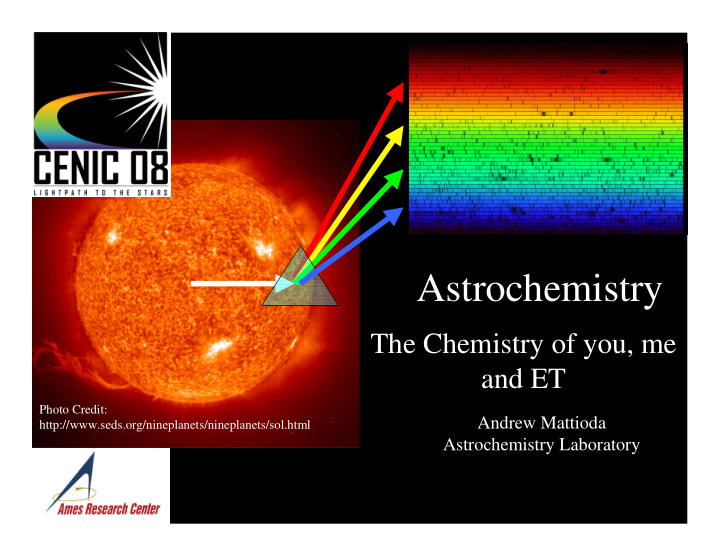



Astrochemistry The Chemistry of you, me and ET Photo Credit: Andrew Mattioda http://www.seds.org/nineplanets/nineplanets/sol.html Astrochemistry Laboratory
Outline of the Talk • Background on Astrochemistry and its relevance to Space Science. • How the measurements are made. • How is the information utilized? • Where do we go from here?
What is Astrochemistry? • Tries to understand the chemistry that can take place in • Tries to understand the chemistry that can take place in • Tries to understand the chemistry that can take place in • Tries to understand the chemistry that can take place in extraterrestrial and astrobiologically interesting extraterrestrial and astrobiologically interesting extraterrestrial and astrobiologically interesting extraterrestrial and astrobiologically interesting environments such as: environments such as: environments such as: environments such as: – Planetary surfaces – Planetary surfaces – Planetary surfaces – Planetary surfaces – Other solar system objects – Other solar system objects – Other solar system objects – Interstellar clouds – Interstellar clouds • Concerned with the production, distribution, and fate of the chemical precursors of life
A little context… A little context… • Space was considered chemically barren for most of the 20th Century • The spell was broken in the 1960’s and 1970’s with these discoveries: OH (early 60’s) NH 3 (1968) H 2 CO (1969)* CO (1970) 11.3 µm emission (1973) * …polyatomic molecules containing at least 2 atoms other than H can form in the interstellar medium.” Snyder, Buhl, Zuckerman, Palmer
Why Study Astrochemistry? • It tells us about the “chemical inventory” available for the origin of life • It provides a record of processes billions of years old • It gives us markers to search for in exploration of extraterrestrial environments
Search for Life in the Solar System: We might get lucky ase.jpl.nasa.gov/
…but the search for life in the Solar System is far more likely to be the search for organic biomarkers OH H Amino acids H O HO H HO H OH OH O H OH Sugars Substituted aromatics NH 2 OH O N Juglone (in walnut & pecan shells) N Bull. Soc. Chim . 1, 800 (1907) N O N H Fatty acids Nucleobases OH OH O Aloe -Emodin Arch. Pharm. 247 , 81 (1909) Nitrogen containing R Rhein (extract of chinese rhubarb) heterocycles O Ann . 50 , 196 (1844)
How is Astrochemistry Studied? • Three main approaches: • Three main approaches: • Three main approaches: • Three main approaches: • Three main approaches: – Remote astronomical measurements – Remote astronomical measurements – Remote astronomical measurements – Remote astronomical measurements – Laboratory simulations – Laboratory simulations – Laboratory simulations – Study of actual samples – Study of actual samples • We must use a combination of all three methods to get a full story
The constellation of Orion The constellation of Orion
The constellation of Orion The constellation of Orion
There is a class of molecules that has been found in meteorites. . . . . . In fact, you might even know what they taste like...
Allamandola, L.J., Astrophysical Journal, 381(1991)181.
Polycyclic Aromatic Hydrocarbons ( Aromatic Hydrocarbons (PAHs PAHs) ) Polycyclic Polycyclic Aromatic Hydrocarbons (PAHs) H They are stable, made mostly H of carbon, and are everywhere. H H H H These sooty molecules H may take up 10-15% of the galactic carbon! H H H H H H They are also H carcinogens H H H H Aliphatic Carbon Molecule PAH Aliphatic Carbon Molecule PAH Propane Anthracene Propane Anthracene Propane Anthracene C 3 H 8 C 14 H 10 C 3 H C 14 H C 3 H 8 C 14 H 10 8 10
How to Pump Up PAHs How to Pump Up PAHs V UV U
Mid- -IR Frequency Ranges Characteristic of IR Frequency Ranges Characteristic of PAHs PAHs Mid CC str CC str /CH ip CH oop CH str 3 4 5 6 7 8 9 10 15 Wavelength (µm) Vibration - S. Langhoff Orion ISO Spectrum - E. Peeters
What’s the next step? • The devil is in the details – use this information as a probe of the interstellar environment. • Create an online, accessible, database for use by astronomers, environmental scientists & educators.
Least squares fit of the spectra in the database to the ISO SWS spectrum of the HII Region IRAS 23133 May, 2006 Cami, 2006
Breakdown of large and small PAHs in the astronomical objects from the Least Squares Fit Cami, 2007 September, 2007
M16 - The Eagle Nebula M16 - The Eagle Nebula Visible Light Visible Light Middle Infrared Near Infrared Middle Infrared Near Infrared ISO/ESA Image 2MASS Image ISO/ESA Image 2MASS Image NOAO Photo NOAO Photo
"All we are is dust in the wind..." Origin of Life •Complex organic molecules form in space. Complex organic molecules form in space. • •Complex organic molecules form in space. Kansas, The Point of No Return •Delivered to planetary surfaces via meteors, Delivered to planetary surfaces via meteors, • •Delivered to planetary surfaces via meteors, comets & dust. comets & dust. comets & dust. •The spectroscopic changes allows us to understand The spectroscopic changes allows us to understand • •The spectroscopic changes allows us to understand the chemical changes. the chemical changes. the chemical changes. Presentation made possible by the Ames Astrochemistry group, Lou, Jamie, Max, Christiaan, & others
Recommend
More recommend